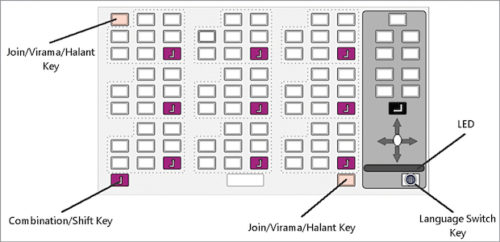The keyboard has brought significant simplicity to the layout of Indic languages
So far, Indic language computer keyboards have all been overlays on keyboards based on QWERTY English keyboard.
A unique patented keyboard layout has been designed for Indic languages (Brahmi based), used in keyboards for language education using computer-aided teaching for India, Nepal, Sri Lanka, Myanmar and Thailand. Brahmi is one of the oldest writing systems used in south and central Asia, mentioned in ancient Indian texts of Hinduism, Buddhism and Jainism, and as well as their Chinese translations.
Schools can now use computers from an early age and learn English using their mother tongue. Also, one can type faster and type in any language using their mother tongue. Anyone from rural areas can connect to their phone and do content creation, translation, speech to text correction, OCR corrections, etc, from their home.
One day Dr Guru Prasad’s son said, “Dad, I do not have to learn the script as I speak Kannada and you speak as well as write, but we both use English keyboard to type Kannada.” That is when Dr Prasad, chief innovation officer, KaNaada Phonetics Pvt Ltd, realised there were no native user interfaces for his language and approached Prof. Sastry, a linguist from Yoga Sanskrutam University, who was also tackling similar issues of saving seven major Brahmi scripts like Kannada, Devanagari and Malayalam from going out of vogue in India in the next fifty years.

Dr Prasad explains, “One of the intricate factors was QWERTY layout of 144 years. The second challenge was the shape of the keyboard. Our swara-vyanjana layout of nine clusters was square in shape, and people did not like the look despite showing the speed at which one could type in their mother tongue.
“We have a unique layout of vowels and consonants, common to all Indic languages. So, we developed a layout for Brahmi lipi-based Indic languages using Shiksha Shastra logic for phonetics. The layout enables one to type thirty per cent faster than QWERTY. With the touch of a button, one can type any Indic language. We redesigned the shape to match aspect ratios the human eye was used to.”
The keyboard can be configured to type in another language. Language controls the characters that appear on the screen. One needs to install at least one language to type using the keyboard, and switch to Ka-Naada input language before typing.
The keyboard has already been deployed in nearly fifty schools, and classes have been given for speed-typing and skills training for e-gov, village panchayat, English learning and content creation. It is priced at ₹ 2200 inclusive of taxes, and is available in ten languages. It can also support such languages as Assamese, Bengali, Devanagari, Hindi, English, Gujarati, Kannada, Malayalam, Kashmiri (Sharada script), Odiya Ka-Naada, Panjabi Ka-Naada, Gurmukhi, Telugu, Tulu and Malayalam.
The keyboard has brought significant simplicity to the layout of Indic languages. A child can learn it in no time, while for adults it takes a couple of hours of training to overcome the bias of QWERTY keyboard. The keyboard has primarily been designed for laptops, desktop computers and Android phones.
One can buy the keyboard for the language of their own choice and the top layout will be printed in the script for that language. The user can use it to type any language in Brahmi family by installing language layouts from Download or CD. No other software or drivers are needed. Once installed, the specific language shows in the language bar along with EN (English). The user can also use language switch button on Ka-Naada, or the shortcuts set to switch between languages. Ka-Naada works in most of the applications that are Unicode-compatible.










